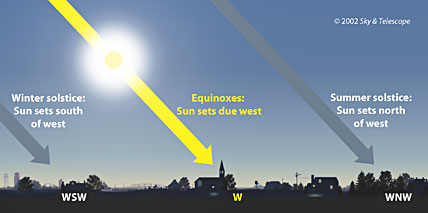September 13, 2002
Contact:
Alan MacRobert, Senior Editor
855-638-5388 x151, [email protected]
Note to Editors/Producers: This release is accompanied by a high-quality animation and illustration; see details below.
The beginning of fall in 2002 will pose a bit of a quandary for weather announcers and others in the news media. Does it happen on September 22nd or 23rd?
That depends on what time zone you’re in. The September equinox happens at 12:55 a.m. Eastern Daylight Time on the morning of the 23rd. But that’s 11:55 p.m. on the evening of September 22nd in Central Daylight Time. In the Mountain and Pacific time zones, fall also starts on the 22nd (at 10:55 and 9:55 p.m. daylight saving time, respectively).
Why the confusion? Why does fall start at such an odd time? And what is the equinox anyway?
The seasons’ starting times are governed by the Earth’s motion around the Sun — or equivalently, from our point of view, the Sun’s annual motion in Earth’s sky. These cycles go about their business with no regard for our timekeeping convenience. The start of fall (for the Northern Hemisphere) is defined as the moment when the Sun passes over Earth’s equator heading south — a moment called the autumnal equinox. This moment can come at any time of day or night.
The Sun appears to move north and south in our sky during the year because of what some might consider an awkward misalignment of our planet. Earth’s axis is tilted with respect to our orbit around the Sun. So when we’re on one side of our orbit, the Northern Hemisphere is tipped Sunward and gets heated by more direct solar rays, making summer. When we’re on the opposite side of our orbit, the Northern Hemisphere is tipped away from the Sun. The solar rays come in at a lower slant to our part of the world and heat the ground less, making winter.
For a skywatcher on Earth (at north temperate latitudes), the effect is to make the Sun appear to move higher in the sky each day from December to June, and back down again from June to December. An equinox comes when the Sun is halfway through each journey.
This celestial arrangement makes several other noteworthy things happen on the equinox date:
- Day and night are almost exactly the same length; the word “equinox” comes from the Latin for “equal night.” (There are two reasons why a look in your almanac will reveal that day and night are not exactly 12 hours long at the equinox. First, sunrise and sunset are defined as when the Sun’s top edge crosses the horizon, not when the Sun’s center crosses the horizon. Second, the Earth’s atmosphere distorts the Sun’s apparent position slightly when the Sun is very low. Have these facts on hand when you get the inevitable calls at the equinox from people saying your sunrise and sunset times are not 12 hours apart.)
- The Sun rises due east and sets due west. The fall and spring equinoxes are the only times of the year when this happens.
- If you were standing on the equator, the Sun would pass exactly overhead in the middle of the day. If you were at the North Pole, the Sun would be skimming the horizon about to begin the six-month polar night.
- In the Southern Hemisphere, the September equinox marks the start of spring, and the March equinox marks the start of fall. Summer for kangaroos begins in December, winter in June.
- Eggs do not balance on end more easily at the equinox than at other times! Actual tests have demolished this bit of New Age goofiness; the ability of eggs to balance depends on tiny irregularities on their shells (and how persistent the would-be balancer is), not on what day it is. “This perennial silly-season story has nothing to do with how eggs balance,” says Sky & Telescope senior editor Alan MacRobert, “and everything to do with how some media can’t say no to a wacky story even if it’s wrong.”
Sky & Telescope is making the following illustrations available to the news media. Permission is granted for one-time, nonexclusive use in print and broadcast media, as long as appropriate credits (as noted in each caption) are included. Web publication must include a link to SkyandTelescope.com.

As seen from the Earth, during the course of a year the Sun migrates from north to south and back again. The Sun is farthest north at the June solstice, farthest south at the December solstice, and crosses the celestial equator at the equinoxes in March and September. These frames are from a 6.7-megabyte QuickTime animation suitable for television broadcast and available for downloading by FTP.
Sky & Telescope illustration.

The Sun rises due east and sets due west on the equinoxes in both March and September. At other times of year it comes up and goes down a bit to the north or south. Click on the image to download a publication-quality JPEG (124 kilobytes) by FTP.
Sky & Telescope illustration.
 0
0
Comments
You must be logged in to post a comment.